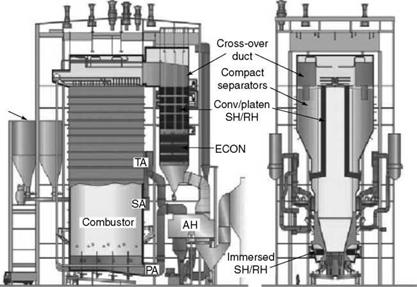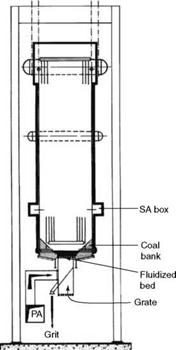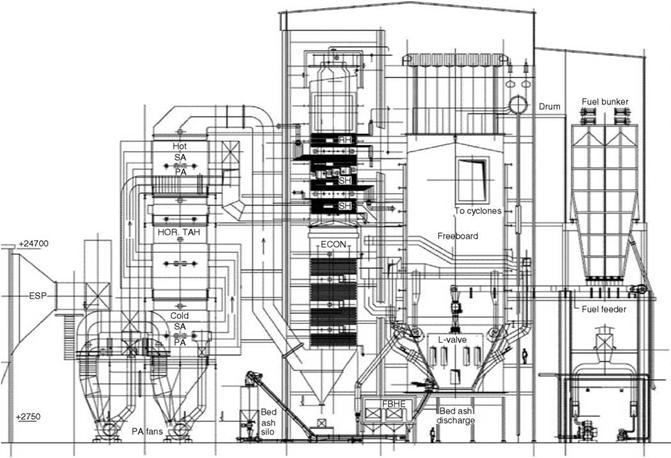Developed in France in the 1950s and patented as Ignifluid technology, these boilers gained a rapid acceptance after the oil crisis in the 1970s and 1980s. Although the other FBC boilers were still under development, this type of fluidized bed boiler was fully ready and in use across the globe. Ignifluid technology can be considered as a true forerunner of the present — day CFBCs. The principles behind the Ignifluid technology are as follows (Figure 12.36):
• High-temperature fluidization in which the bed temperature was held between 900 and 1200°C (1650-2200°F) simply by staged combustion, depending on the fuel.
• No bed tubes.
• The temperature was high enough to agglomerate and form a small clinker. The ash discharge was as simple as in a stoker-fired boiler.
• An inclined grate would carry away the clinker from the fluidized bed.
• The fluidizing velocities were ~4 m/s, close to the velocities of the present expanded bed.
• The grate was an ash carrier and air distributor. Unlike a conventional grate, it did not participate in combustion beyond air distribution and fuel support.
• No bed air nozzles for air distribution, a function performed by the grate.
• Cinder recirculation for enhanced combustion efficiency.
• The boiler construction was very conventional with bidrum or single-drum design.
• Sorbent feeding could be done from the SA nozzles.
|
|
|
+52500 +48000 +41700 +40500 |
|
+28000 +18500 +10000 +6500 +/-0 |
|
Fluidized Bed Combustion 555 |
![]() FIGURE 12.33
FIGURE 12.33
Typical 125 MW lignite-fired hot cyclone circulating fluidized bed combustion boiler with two cyclones. AH, airheater; EC ON, economizer; ESP, electrostatic precipitator; FBHE, fluid bed heat exchanger; PA, primary air; SA, secondary air; SH, superheater; TAH, tubular airheater. (From AE&E-Lentjes GmbH, Germany. With permission.)
|
556 Boilers for Power and Process |
|
Feed Water |
|
ECON |
|
|||
|
|||
|
|||
|
|||
|
|
||
|
|||
|
|
||
|
|
||
|
|||
|
|||
|
|||
|
|||

|
|
|

|
|
|
Flue gas to MDC |
|
Clinker Discharge |
|
FIGURE 12.36 Principle of Ignifluid boiler. MDC, mechanical dust collector; PA, primary air; SA, secondary air; SH, superheater. |

• The concept was sound, and the boilers displayed reliability and ruggedness.
• Boilers for burning several fuels were commissioned—anthracite, coals of different origins, lignites, coffee grounds, etc.
• As the bed contained only carbon, the load response was very good.
• A stepless turndown of 1:4 was normal.
• The operation was nearly as simple as running a stoker-fired boiler, without heavy maintenance.
A boiler with 380 tph capacity built in 1989 was then the largest FBC. With the advent of stringent pollution norms, the manufacturer had to withdraw from developed markets because
• The NOx was slightly higher at 300 mg/N m3 against <200 mg/N m3.
• The desulfurization from SA nozzles was limited to 60-80% as against 85-95% with the CFB technology.
In the developing markets, for high-ash coals, the unburnt loss was —6%, which could not compete with —4 and 1% of BFBC and CFBC, respectively. The Ignifluid is outdated today, but it should be remembered as the first of fully developed FBC boiler and several installations continue to work around the world.
Further Readings
Belin, F. et al., 1999, Update of operating experience of B&W IR CFB coal fired boilers, presented at 15th International Conference on FBC, May.
Bella, F. et al., 2001, CFB boilers—Design and experience, presented at 16th International Conference on FBC, May.
Darling, S. L. and Li, S., 2000, Wheeler experience of clean coal technology in China, FWEI, Foster Wheeler Internal Publication, Clinton, NJ.
Darwis, P. and Darling, S. L., 1998, Sonoco’s compact CFB boiler reduces costs and emissions, Presented at 1998 TAPPI Engineering Conference, Clinton, NJ, September.
Electric Power International, 1994, Circulating fluidised bed boiler technology, September.
Gould, G. L. and McComas, M. W., 1987, Know how efficiencies vary among fluidised bed boilers, Power.
Holta, A. and Venalaloen, I., 2006, Design and scale-up philosophy of once-through CFB boilers with supercritical parameters, VGB Power Tech, April.
Kestner, D. and Steller, P., 1994, Circofluid—A new concept for steam generators with fluidised bed combustion, Deutsche Babcock.
Kurp, J. et al., 2005, Fluidized bed combustion technology in Poland, VGB Power Tech, April.
Makansi, J., 1990, Fluidised bed technology expands options for solid fuel firing, Power, June.
Makansi, J. and Schwieger, B., 1982, Fluidised bed boilers—A special report, Power, August.
Makansi, J. and Schwieger, B., 1987, Fluidised bed boilers—A special report, Power, May.
Maryamchik, M. and Wietzeke, D. L., 2000, CFB design approach comparison, presented to POWERGEN International 2000, Babcock and Wilcox, USA, November.
Nottenkaemper and Bijmholt, D. I., 1987, Investigations of mass flows and emissions in fixed atmospheric fluidised bed combustors and their effect on further development of fluidised bed technology, Deutsche Babcock.
Schwieger, B., 1985, Fluidised bed boilers achieve commercial status world-wide—A special report, Power, February.
The New Romerbrucke FBC combined heat and power plant, Report 217, Deutsche Babcock, 1990.
Walkoviac, R. et al., 2001, The biggest compact boilers in the world, Foster Wheeler Review, Spring.



 12 сентября, 2013
12 сентября, 2013  admin
admin 

 Опубликовано в рубрике
Опубликовано в рубрике